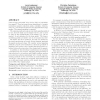110
click to vote
SIAMCOMP
2011
14 years 7 months ago
2011
Reingold, Vadhan and Wigderson [21] introduced the graph zig-zag product. This product combines a large graph and a small graph into one graph, such that the resulting graph inher...
109
Voted
CIKM
2009
Springer
15 years 4 months ago
2009
Springer
We study query processing in large graphs that are fundamental data model underpinning various social networks and Web structures. Given a set of query nodes, we aim to find the g...
115
click to vote
MLG
2007
Springer
15 years 6 months ago
2007
Springer
—Defining the support (or frequency) of a subgraph is trivial when a database of graphs is given: it is simply the number of graphs in the database that contain the subgraph. Ho...
97
Voted
ICDM
2007
IEEE
15 years 7 months ago
2007
IEEE
—Defining the support (or frequency) of a subgraph is trivial when a database of graphs is given: it is simply the number of graphs in the database that contain the subgraph. Ho...
105
click to vote
ICDM
2008
IEEE
15 years 7 months ago
2008
IEEE
While data mining in chemoinformatics studied graph data with dozens of nodes, systems biology and the Internet are now generating graph data with thousands and millions of nodes....
CSE
2009
IEEE
15 years 7 months ago
2009
IEEE
Abstract—We present here a method for analyzing the neighborhoods of all the vertices in a large graph. We first give an algorithm for characterizing a simple undirected graph t...
101
Voted
EDBT
2009
ACM
15 years 7 months ago
2009
ACM
Currently, a huge amount of biological data can be naturally represented by graphs, e.g., protein interaction networks, gene regulatory networks, etc. The need for indexing large ...
106
click to vote
ICDE
2009
IEEE
15 years 7 months ago
2009
IEEE
— Given a large graph and a set of objects, the task of object connection discovery is to find a subgraph that retains the best connection between the objects. Object connection...
KDD
2004
ACM
16 years 1 months ago
2004
ACM
We define a connection subgraph as a small subgraph of a large graph that best captures the relationship between two nodes. The primary motivation for this work is to provide a pa...
112
Voted
KDD
2006
ACM
16 years 1 months ago
2006
ACM
Given a huge real graph, how can we derive a representative sample? There are many known algorithms to compute interesting measures (shortest paths, centrality, betweenness, etc.)...




